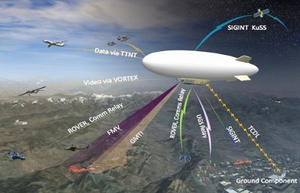BlimpsAir Force to deploy supercomputer aboard a superblimp
The U.S. Air Force is developing a massive blimp to gather and process all intelligence feeds from Afghanistan; the air ship will be longer than a football field and seven times the size of the Goodyear Blimp and will be able to stay afloat for nearly a week at nearly four miles up; the key feature of the ship will be its sophisticated supercomputer which can process 300 terabytes of data an hour; this computer will help limit data overload as surveillance sensors become increasingly complex; it currently takes fourteen analysts to monitor a single feed from a predator and the next generation drones will have ninety-six cameras; the blimp’s first test flight is scheduled for 15 October

Superblimp's super data handling capability // Source: techalps.com
As police departments in the United States continue to float the idea of using blimps as surveillance vehicles, the Air Force is pressing ahead with its plan to launch a massive blimp that would function as a centralized intelligence command center in Afghanistan.
The air ship, seven times the size of the Goodyear Blimp, would fly at 20,000 feet and collect data from the various unmanned surveillance drones patrolling the skies. The supercomputer housed aboard the blimp will sift the various data streams and automatically direct sensors to collect critical information.
The Air Force already monitors all the video and audio streams from surveillance drones, but the time it takes to personnel to determine which bits of information are critical have sometimes allowed the enemy to escape.
The supercomputer is designed to cut down on this lag time and feed coordinated information to troops on the ground in less than fifteen seconds.
Lt. Gen. David Deptula, the recent head of the Air Force’s intelligence operations believes the project “could change the nature of overhead surveillance.” He says, “There’s huge potential there.”
The next generation of surveillance equipment, Gorgon Stare and wide-area airborne surveillance systems (WAAS), use hives of a dozen cameras to film areas within a 2.5 mile radius. With as many as ninety-six cameras, these drones can cause massive data overloads for both human operators and digital networks.
It currently requires nineteen analysts to watch a single feed from a Predator drone. With the next generation surveillance equipment, a single drone would generate 274 terabytes of data every hour from its ninety-six cameras.
Gen. James Cartwright, vice chairman of the Joint Chiefs of Staff, said that he would need 2,000 analysts to process the information collected by a single drone using WAAS sensors.
To prevent this information overload from overwhelming intelligence analysts, the Air Force is designing the supercomputer to be housed aboard the Blue Devil.
The computer will have the equivalent of 2,000 single-core servers and process up to 300 terabytes an hour. Instead of sending all of this processed information to troops, like with today’s sensors, the Blue Devil’s processors will calculate the data and filter it into an easily searchable format. Troops on the ground will then be able to search the ship’s computer for relevant information.
Lt. Gen. Deptula explains that this process will reduce bandwidth consumption.
“People ask: ‘With all these sensors, how’re you gonna transmit all that data down to the ground?’ Well, we don’t necessarily need to send it all down,” said Deptula.“ A potential solution is to process part of the data on-board, and only send what is of interest. That reduces the bandwidth requirements.”
The ambitious project dubbed “Blue Devil” will cost $211 million and is currently in its second phase of development.
According to Wired Magazine’s Danger Room, a source close to the project says the Blue Devil will be “one of the largest airships produced since World War II.”
“It’s freakishly large,” the source adds.
When completed, the airship will be longer than a football field at 350 feet and seven times the size of the Goodyear Blimp at 1.4 million cubic feet.
The blimp’s unprecedented size will help it carry enough fuel and helium to stay afloat for as long as a week at nearly four miles up. Most blimps fly at 3,000 feet or less.
The U.S. Army is also at work on a competing airship project, the Long Endurance Multi-Intelligence Vehicle, that could stay afloat for nearly three weeks thanks to a sophisticated hybrid hull.
The Air Force is focusing its efforts on designing a complex set of onboard sensors and a supercomputer, rather than concentrating on hull design.
In addition to the supercomputer, the airship will carry on-board listening devices, a WAAS system, day and night cameras, and communications relays and receivers for ground sensors.
The Blue Devil’s first test flight is scheduled for 15 October.
